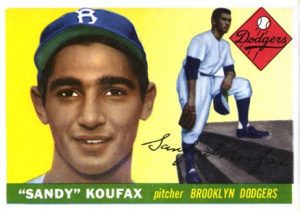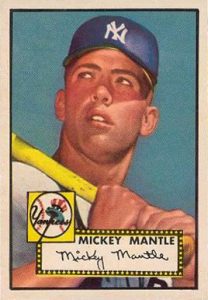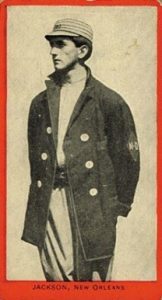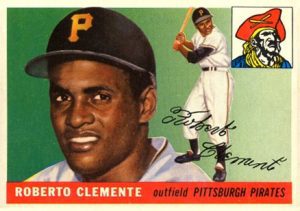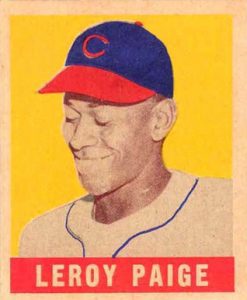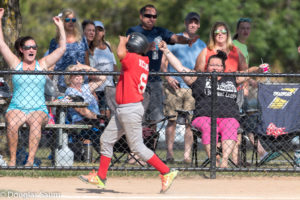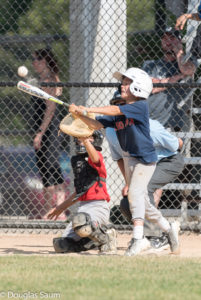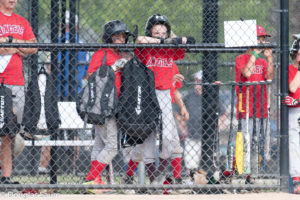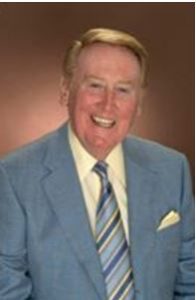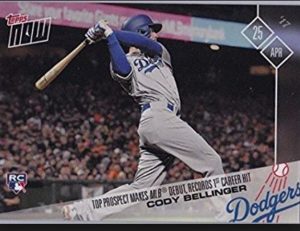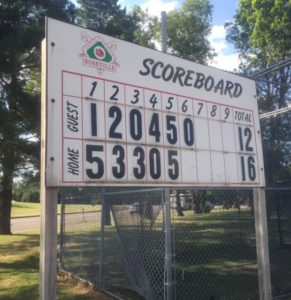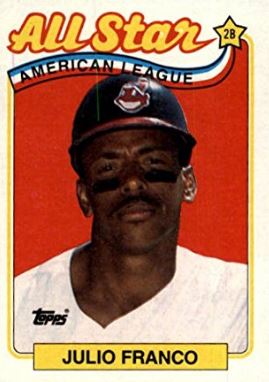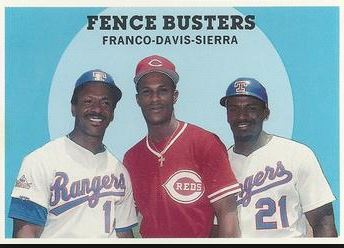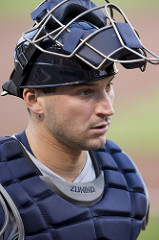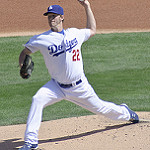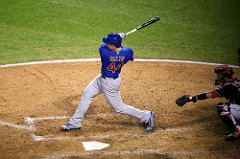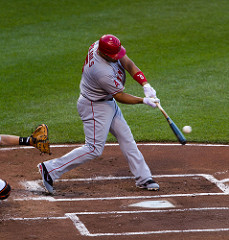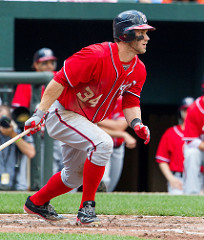
Bryce Harper. Photo by Keith Allison 
Yesterday, the Washington Nationals tied an MLB record by bashing five home runs in one inning – as they scored seven runs in the third inning of a 15-2 bashing of the Brewers in Washington. It was the only the sixth time an MLB team has notched a five-dinger inning and featured long balls by CF Brian Goodwin (his tenth of the season); SS Wilmer Difo (third of the season); RF Bryce Harper (27th); 1B Ryan Zimmerman (21st); and 3B Anthony Rendon (21st). We’ll take a look at the historic innings in detail in this post, but here are a few facts from th MLB’s five-homer innings.
- A five-HR inning has been achieved five times in the NL – just once in the AL, by the Minnesota Twins on June 9, 1966.
- The Cincinnati Reds have been the victims of four of the six five-homer innings.
- The Milwaukee Brewers are the only team to both give up a five-homer inning and achieve a five-homer inning.
- The home team has put on the power display five of the six times.
- Fourteen of the 30 home runs have come with two outs.
- Pitchers have contributed (as hitters) HRs in two of the six five-homer innings.
- The Reds have been the “victims” in four of the six five-homer frames.
- One of the five-homer innings was kept alive by three fielding errors.
- One of the five-homer innings included two home runs by one player in the inning.
- Two of the six power outbursts included an inside-the-park home run.
- The five-homer innings have featured the scoring of 50 runs – the fewest at six, the most at 12.
Now, let’s take a closer look at those five-homer barrages.
AMERICAN LEAGUE
June 9, 1966 … Minnesota Twins versus Kansas City Athletics
Things did not start out well for the Twins on the day of their historic power display. With the game being played at Metropolitan Stadium (Bloomington, MN), the Athletics got off to a fast start, knocking out Twins’ ace Camilo Pascual in the top of the first. (Pascual lasted 2/3 of an inning, giving up four runs on three hits and a walk.) With Catfish Hunter on the mound, the Twins’ chances looked slim. The Twins scored one in the fifth and two in the sixth (on a Harmon Killebrew home run) and then, trailing 4-3, broke the game open with five home runs in the seventh.
It started innocently enough with a Catfish Hunter walk to C Early Battey, followed by an infield fly out for 2B Bernie Allen. That brought pinch hitter (for the pitcher) Rich Rollins to the plate, and he hit the inning’s first homer (just the second of ten HRs Rollins would hit in 1966). Lead-off hitter SS Zoilo Versalles followed with his fifth homer of the year – and Paul Lindblad replaced Hunter on the mound. Lindblad got Twins’ LF Sandy Valdespino on a grounder to short, but then gave up consecutive round trippers to RF Tony Oliva (his 14th) and 1B Don Mincher (his 6th). That brought John Wyatt in from the bullpen and he quickly gave up a home run to 3B Harmon Killebrew (his second of the day and 11th of the year). Wyatt then gave up a double to RF Jimmie Hall and C Earl Battey reached on an error before 2B Bernie Allen ended the inning on a ground ball (catcher to first).
The Inning’s HR Hitters: Rich Rollins, Zoilo Versalles, Tony Oliva, Don Mincher, Harmon Killebrew
Final Score: Twins 9 – Athletics 4
_____________________________________
NATIONAL LEAGUE
June 6, 1939 … NY Giants versus Cincinnati Reds
The first-ever five-home run MLB inning took place in New York on June 6, 1930, as the sixth-place Giants (20-24 record) surprised the league-leading Reds (29-15) by a 17-3 score, plating all 17 runs in the first five innings.
The record-setting power display came in the bottom of the fourth inning, with the Giants already up 6-0. Peaches Davis, who had relieved Johnny Vander Meer in the first inning (Vander Meer had given up six hits and three runs in 2/3 of an inning), retired Giants’ LF Jo Jo Moore and SS Billy Jurgess to start the inning. Then the wheels came off. C Harry Danning laced a home run to center (his sixth). Then clean-up hitter Mel Ott drew a walk, 1B Zeke Bonura singled and CF Frank Demaree hit the second home run of the inning (his second of the season). That ended Davis’ day and brought Wesley Livengood (whose MLB career would consist of five appearances and a 9.53 ERA) to the hill. Livengood was not so good, he walked Tony Lazzeri and then gave up a home run to 2B Burgess Whitehead (the first of only two he would it in 1939). Giants’ pitcher Manny Salvo was up next. A weak hitter (at best), Salvo surprised everyone in the ball park with the only home run of his five-season MLB career – an inside-the-park round tripper off the right field fence. Next up was lead-off hitter Jo Jo Moore, who hit the fifth and final homer of the inning (and his second of the day). And, all of this with two out. Livengood’s line for the day: 1/3 inning pitched, three hits, two walks, four earned runs (3 HRs).
The Inning’s Home Run Hitters: Harry Danning, Frank Demaree, Burgess Whitehead, Manny Salvo, Jo Jo Moore
Final Score: Giants 17 – Reds 3
____________________________________
June 2, 1949… Philadelphia Phillies versus Cincinnati Reds
Ten seasons passed before the next five-homer inning – and the victims were again the Reds. This time the bashing came off the bats of the Phillies (in Philadelphia). It started out as a close game, with the Reds actually leading 3-2 after seven innings behind a strong performance by starting pitcher Ken Raffensberger (who would win 18 games that season). Things, however, went awry in the bottom of the eighth.
CF Del Ennis (the Phillies’ clean-up hitter) led off the inning with a home run (his seventh of the season), which was followed by C Andy Seminick’s second home run of the game – marking Raffensberger’s exit. Jess Dobernic came on in relief and retired RF Stan Hollmig on a liner to short before giving up a home run to 3B Willie Jones (his third of the year). Dobrenic then induced a soft fly ball out to second base by 2B Eddie Miller, bringing up P Schoolboy Rowe, who had relieved Philadelphia starter Curt Simmons in the top of the eighth (Stan Lopata had pinch hit for Simmons in the bottom of the seventh.) Rowe promptly rapped a home run to left (the only home run of the year for the 39-year-old veteran, in his last MLB season). Kent Petersen came on in relief of Dobernic and added fuel to the fire in this order: walk to CF Richie Ashburn, double to SS Granny Hamner, 1B Eddie Waitkus safe on an error (Ashburn scores), an Ennis single to right (Hamner scores), and Seminick’s second home run of the inning (third of the game and seventh of the season). That was the end of the home runs, but the inning continued with the Phillies adding another run on a hit batsman and a triple. Suddenly a 3-2 Reds lead was a 12-3 deficit.
The Inning’s Home Run Hitters; Del Ennis, Andy Seminick (2), Willie Jones, Schoolboy Rowe
Final Score: Phillies 12 – Reds 3
________________________________
August 23, 1961 … San Francisco Giants versus Cincinnati Reds
Twelve seasons after five-home inning number two, it happened again – and for the third straight time, the Reds were the victims – and this time they were at home. On August 23, 1961, another close game became a late-inning route. The Reds trailed the San Francisco Giants 2-0 after eight innings with both starters (Juan Marichal for the Giants and Joey Jay for the Reds) still in the game. A low-scoring game was expected, Marichal game into the contest with a 12-7 record for the third-place Giants, while Jay was 18-7 for the first-place Reds.
In the top of the ninth, however, the Giants broke the contest wide open. 1B Willie McCovey opened with a double off Jay and then scored on an error by Reds’ 2B Don Blasingame after a Willie Mays pop out. LF Orlando Cepeda and RF Felipe Alou followed with a pair of deep home runs (to center and left, respectively). It was Cepeda’s 36th of the year and Alou’s 15th. That brought Jim Brosnan in from the bullpen – and led to a fly ball out by C John Orsino, singles to SS Jose Pagan and Marichal, 2B Joey Amalfitano reaching on an error by Reds’ third baseman Gene Freese (Pagan scoring), a three-run inside-the-park home run by 3B Jim Davenport (his 8th homer of the year) and a single to McCovey. Next in the line of fire (relieving Brosnan) was Bill Henry, who gave up a two-run homer to Willie Mays (his 34th of the season), a single to Cepeda, and had Alou reach on Freese’s second error of the inning (and the Reds’ third miscue of the frame). Orsino then took Henry deep (just his second of the year) before Pagan struck out to mercifully end the 12-run, ninth-inning uprising.
The Inning’s Home Run Hitters: Orlando Cepeda, Felipe Alou, Jim Davenport, Willie Mays, John Orsino
Final Score: Giants 14 – Reds 0
______________________
April 22, 2006 … Milwaukee Brewers versus Cincinnati Reds
The Brewers were less than hospitable hosts to the Reds on April 22, 2006 – when they pounded the visitors 11-0, racking up the fourth five-homer inning against the Reds’ franchise along the way. The outburst came in the bottom of the fourth inning with starter Brandon Claussen still on the mound and the Reds trailing 3-0.
Milwaukee 3B Bill Hall (the number-six hitter) started it with a home run (his third of the young season). Then 2B Richie Weeks singled to left, scoring on C Damian Miller’s home run (his first of the year). That seemed to establish a (brief) HR-1B-HR pattern, as Brewers’ pitcher Dave Bush followed the Miller home run with a single and CF Brady Clark backed up the Bush single with his first home run of 2006. SS J.J. Hardy broke the pattern with a home run (his 3rd of the year). At this point, Claussen had faced six batters in the inning, giving up four home runs and two singles – and his day was done. Chris Hammond came on in relief and provided just that, striking out the first two batters he faced (RF Geoff Jenkins and LF Carlos Lee). Then Prince Fielder gave the Brewers a piece of the five-homer in one inning record, hitting his third of the year. The carnage ended on a fly out to center by Hall.
The Inning’s Home Run Hitters: Bill Hall, Damian Miller, Brady Clark, J.J. Hardy, Prince Fielder
Final Score: Brewers 11 – Reds 0
_______________________________
July 27, 2017 … Washington Nationals versus Milwaukee Brewers
The Nationals (60-39, running away with the NL East) faced off (at home) against the Milwaukee Brewers, who were trying to keep pace with the division-leading Cubs in the NL Central. Washington was starting its staff “ace” – Max Scherzer – going for his twelfth win. Milwaukee countered with Michael Blazek getting his first start of the season (fifth appearance). It was also the first start of Blazek’s four MLB seasons (109 appearances). After Scherzer worked a 1-2-3 top of the first, Blazek gave up a two-run home run to Bryce Harper to fall behind 2-0. Neither team scored in the second and Scherzer continued to hold the Brewers scoreless in the top of the third.
In the bottom of the third, Scherzer drew a walk to start things off. CF and leadoff hitter Brian Goodwin followed with a home run to right (his tenth HR of the season); Then SS Wilmer Difo hit one out to right-center (his third HR of the season); RF Bryce Harper hit his second long ball of the game (27th of the season) to left-center; and Ryan Zimmerman added the fourth consecutive blast of the inning (his 21st of the year) to left-center. Daniel Murphy followed with a fly out to center, and 3B Anthony Rendon followed with the fifth homer of the inning (his 21st), this one to straight-away center. That prompted a pitching change. New Brewer moundsman Wily Peralta gave up two singles and a double – and one more run – before getting out of the inning. At the end of the frame, the score stood Washington 9 – Milwaukee. And, the Nationals weren’t done yet. They added six more runs in the bottom of the fourth on five hits (two more home runs) and a walk.
The Inning’s Home Run hitters: Brian Goodwin; Wilmer Difo; Bryce Harper; Ryan Zimmerman; Anthony Rendon
Final Score: Nationals 15-Bewers 2
FOUR IN A ROW – THAT’S A RECORD, TOO!
The Nationals also became just the eighth tEAM to hit four consecutive home runs in an inning. Here’s the list.
Boston Red Sox: April 22, 2007 – Manny Ramirez, J.D. Drew, Mike Lowell, Jason Varitek
LA Dodgers: September 18, 2006 – Jeff Kent, J.D. Drew, Russell Martin, Marlon Anderson
Minnesota Twins: May 2, 1964 – Tony Oliva, Harmon Killebrew, Bob Allison, Jimmie Hall
Cleveland Indians: July 31, 1963 – Woodie Held, Pedro Ramos, Tito Francona, Larry Brown
Milwaukee Braves: June 8, 1961 – Eddie Mathews, Hank Aaron, Joe Adcock, Frank Thomas
Chicago White Sox: August 14, 2008 – Jim Thome, Paul Konerko, Alexei Ramirez, Juan Uribe
Arizona D-backs: August 11, 2010 – Adam LaRoche, Miguel Montero, Mark Reynolds, Stephen Drew
Washington Nationals: July 27, 2017 – Brian Goodwin, Wilmer Difo, Bryce Harper, Ryan Zimmerman
I tweet baseball @DavidBBRT
Follow/Like Baseball Roundtable’s Facebook page – here.
Member: Society for American Baseball Research (SABR); The Baseball Reliquary; The Negro Leagues Baseball Museum; Baeball Bloggers Alliance.
Y







